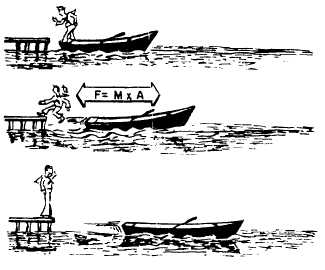modern philosophy concerning gravity and
motion. Before we discuss motion and other
related factors, you should be familiar with
Newton’s laws. These laws are the bases for the
theories of physics that we describe in the
following sections.
NEWTON’S FIRST LAW
Newton’s first law states that a body at rest
tends to remain at rest. A body in motion tends
to remain in motion. This law can be demon-
strated easily in everyday use. For example, a
parked automobile will remain motionless until
some force causes it to move—a body at rest tends
to remain at rest. The second portion of the law—
a body in motion tends to remain in motion—can
be demonstrated only in a theoretical sense. The
same car placed in motion would remain in
motion (1) if all air resistance were removed,
(2) if no friction were in the bearings, and (3) if
the surface were perfectly level.
NEWTON'S SECOND LAW
Newton’s second law states that an imbalance
of force on a body tends to produce an accelera-
tion in the direction of the force. The acceleration,
if any, is directly proportional to the force. It is
inversely proportional to the mass of the body.
This law can be explained by throwing a common
softball, The force required to accelerate the ball
to a rate of 50 ft/sec2 would have to be doubled
to obtain an acceleration rate of 100 ft/sec2.
However, if the mass of the ball were doubled,
the original acceleration rate would be cut in half.
You would have 50 ft/sec2 reduced to 25 ft/sec2.
NEWTON'S THIRD LAW
Newton’s third law states that for every action
there is an equal and opposite reaction. You have
demonstrated this law if you have ever jumped
from a boat up to a dock or a beach. The boat
moved opposite to the direction you jumped. The
recoil from firing a shotgun is another example
of action-reaction. Figure 2-4 depicts these
examples.
In an airplane, the greater the mass of air
handled by the engine, the more it is accelerated
by the engine. The force built up to thrust the
plane forward is also greater. In a gas turbine,
Figure 2-4.—Newton’s third law of motion.
the thrust velocity can be absorbed by the turbine
rotor and converted to mechanical energy. This
is done by the addition of more and progressively
larger power turbine wheels.
SPEED, VELOCITY,
AND ACCELERATION
SPEED is defined as the distance covered per
unit of time, such as a car traveling at 60 mph.
VELOCITY is speed in a certain direction, such
as a car traveling due north at 60 mph.
ACCELERATION is the rate at which velocity
increases. If, for example, the propeller shaft rate
of rotation increases from stop to 100 rpm in
20 minutes, the acceleration is 5 rpm per minute.
In other words, the velocity has increased 5
revolutions per minute, during each minute, for
a total period of 20 minutes. A body moving at
2-5




